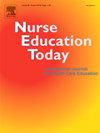男护生角色应变量表的编制与初步验证
IF 3.6
2区 医学
Q1 EDUCATION, SCIENTIFIC DISCIPLINES
引用次数: 0
摘要
由于职业性别隔离和社会性别刻板印象,男性护理学生在学习和临床实践中面临许多挑战。虽然有针对男女护生的角色压力量表,但它并没有专门设计用于评估男性护生在社区、家庭、同伴和护理教育等方面的角色压力。目的编制男护生角色压力量表并进行初步验证。方法采用三个阶段的方法对量表进行编制和验证,包括量表的编制、理论分析和对163名男护生的信度和效度的心理测量分析。结果编制了一个12项的角色压力量表,包括“家人和朋友角色压力”、“同学和老师角色压力”、“医务人员角色压力”和“患者角色压力”四个维度,解释了63.47%的方差。来自老师和同学的角色压力是男护士所经历的独特的。不同意向男护生在整体角色应变上存在显著差异;角色压力较高的受访护士从事临床护理工作的意愿较低(F = 4.81, p = 0.003),支持量表的区分效度。总体Cronbach’s α为0.733,两周重测显示类内相关系数为0.767,信度较好。结论首次编制了男护生角色应变量表,信效度较好。该量表有助于了解男护生所经历的角色压力,并为未来的护理教育和政策制定提供支持。建议验证该量表在不同文化和国家的适用性,以更全面地了解男护生的角色紧张现象。本文章由计算机程序翻译,如有差异,请以英文原文为准。
Development and initial validation of a role strain scale for male nursing students
Background
Male nursing students face numerous challenges in learning and clinical practice due to occupational gender segregation and societal gender stereotypes. Although there is a role strain scale for nursing students of both genders, it is not specifically designed to assess role strain in areas such as community, family, peers, and nursing education among male nursing students.
Purpose
To develop and initially validate a Role Strain Scale for male nursing students.
Methods
This study employed a three-phase approach to develop and validate the scale, including item generation, theoretical analysis, and psychometric analysis for reliability and validity among 163 male nursing students.
Results
A 12-item Role Strain Scale was developed to include four dimensions: “Family and Friend Role Strain,” “Classmate and Teacher Role Strain,” “Medical Personnel Role Strain,” and “Patient Role Strain,” explaining 63.47 % of the variance. The role strain from teachers and classmates is unique from that experienced by male nurses. Male nursing students with different intentions to enter the nursing profession showed significant differences in overall role strain; those experiencing higher role strain had lower intentions to engage in clinical nursing work (F = 4.81, p = 0.003), supporting the scale's discriminant validity. Additionally, the overall Cronbach's α was 0.733, and a two-week test-retest showed an intraclass correlation coefficient of 0.767, indicating good reliability.
Conclusion
The Role Strain Scale for male nursing students is the first developed with satisfactory reliability and validity. This scale helps understand the role strain experienced by male nursing students and supports future nursing education and policy-making initiatives. It is recommended to validate the applicability of this scale across different cultures and countries to gain a more comprehensive understanding of the role strain phenomenon among male nursing students.
求助全文
通过发布文献求助,成功后即可免费获取论文全文。
去求助
来源期刊

Nurse Education Today
医学-护理
CiteScore
6.90
自引率
12.80%
发文量
349
审稿时长
58 days
期刊介绍:
Nurse Education Today is the leading international journal providing a forum for the publication of high quality original research, review and debate in the discussion of nursing, midwifery and interprofessional health care education, publishing papers which contribute to the advancement of educational theory and pedagogy that support the evidence-based practice for educationalists worldwide. The journal stimulates and values critical scholarly debate on issues that have strategic relevance for leaders of health care education.
The journal publishes the highest quality scholarly contributions reflecting the diversity of people, health and education systems worldwide, by publishing research that employs rigorous methodology as well as by publishing papers that highlight the theoretical underpinnings of education and systems globally. The journal will publish papers that show depth, rigour, originality and high standards of presentation, in particular, work that is original, analytical and constructively critical of both previous work and current initiatives.
Authors are invited to submit original research, systematic and scholarly reviews, and critical papers which will stimulate debate on research, policy, theory or philosophy of nursing and related health care education, and which will meet and develop the journal''s high academic and ethical standards.
 求助内容:
求助内容: 应助结果提醒方式:
应助结果提醒方式:


